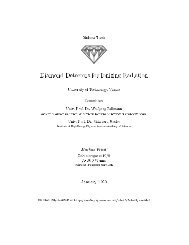You also want an ePaper? Increase the reach of your titles
YUMPU automatically turns print PDFs into web optimized ePapers that Google loves.
The goal of this project was to remedy these problems through the development ofnew software components, making testing easily accessible and painless to allow itsintegration into everyday operation of the experiment.5.2 Implemented Tests5.2.1 Function TestsFunction tests are a category of tests designed to verify the overall functioning of theGT/GMT system in conditions close to those found during normal operation. Thetests simulate all the inputs to the global trigger and compare the results in the formof the global trigger readout records (as sent to the DAQ/EVM systems from theGTFE) with expected values.Input SimulationThe function test simulates all input to the GT and the GMT. Inputs that are processedthrough PSB cards can be simulated by enabling simulation memories on thePSB cards. While the inputs for the GT from the GMT also provide a simulationoption, the simulation memory in the GMT sorter chip is limited to a size of 1024bunch crossings. Since the PSB memories as well as the GMT input memories allowthe simulation of an entire LHC orbit (3564 bunch crossings), the simulation startsat the GMT inputs (the muon quadruplets from the four regional muon triggers) andruns the GMT alongside the rest of the system, allowing the use of all 3564 bunchcrossings for testing.Input GenerationThe input of a function test requires information for all the inputs to the GT aswell as the GMT. In addition to information representing the inputs to the system,it also needs reference outputs to verify that the system is operating correctly. Thisentire information adds up to 2328 bits for each bunch crossing, detailed in Table5.1. A portable representation of this information existed before this project in theform of the “pattern file” format - a text file representing this information in 119columns of hexadecimal numbers, with one line per event. Since this format wasalready established with the existing software infrastructure and contains a fairly gooda human-readable representation of the electronics-level view of the system, it was alsoadopted as the specification format for function tests of the system.In order to conduct tests with realistic inputs from either physics data or MonteCarlo simulations, the event data therefore needs to be converted to the pattern fileformat from the CMSSW format that the datasets are originally produced in. Thisis done using an analyzer framework module called L1GtPatternGenerator, whichcreates the pattern file from digis-level inputs. Most of the information stored in apattern file is available from the object representations in the exact format needed, so52












